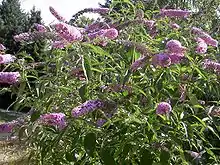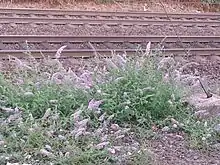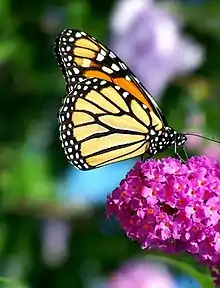Buddleja davidii
Buddleja davidii (spelling variant Buddleia davidii), also called summer lilac, butterfly-bush, or orange eye, is a species of flowering plant in the family Scrophulariaceae, native to Sichuan and Hubei provinces in central China, and also Japan.[1] It is widely used as an ornamental plant, and many named varieties are in cultivation. B. davidii is named after the French missionary and explorer in China, Father Armand David, who was the first European to report the shrub. It was found near Ichang by Dr Augustine Henry about 1887 and sent to St Petersburg. Another botanist-missionary in China, Jean-André Soulié, sent seed to the French nursery Vilmorin, and B. davidii entered commerce in the 1890s.[2]
| Buddleja davidii | |
|---|---|
 | |
| Scientific classification | |
| Kingdom: | Plantae |
| Clade: | Tracheophytes |
| Clade: | Angiosperms |
| Clade: | Eudicots |
| Clade: | Asterids |
| Order: | Lamiales |
| Family: | Scrophulariaceae |
| Genus: | Buddleja |
| Species: | B. davidii |
| Binomial name | |
| Buddleja davidii | |
| Synonyms | |
| |
B. davidii was accorded the RHS Award of Merit (AM) in 1898, and the Award of Garden Merit (AGM) in 1941.[3]
Description
Buddleja davidii is a vigorous shrub with an arching habit, growing to 5 m (16 ft) in height. The pale brown bark becomes deeply fissured with age. The branches are quadrangular in section, the younger shoots covered in a dense indumentum. The opposite lanceolate leaves are 7–13 cm (3–5 inches) long, tomentose beneath when young. The honey-scented lilac to purple inflorescences are terminal panicles, < 20 cm (8 inches) long.[4] Flowers are perfect (having both male and female parts), hence are hermaphrodite rather than monoecious (separate male and female flowers on the same plant) as is often incorrectly stated. Ploidy 2n = 76 (tetraploid).[5]
Buddleja davidii, after Leeuwenberg
In his 1979 revision of the taxonomy of the African and Asiatic species of Buddleja, the Dutch botanist Anthonius Leeuwenberg sank the six varieties of the species as synonyms of the type, considering them to be within the natural variation of a species, and unworthy of varietal recognition.[6] It was Leeuwenberg's taxonomy which was adopted in the Flora of China[7] published in 1996. However, as the distinctions of the former varieties are still widely recognized in horticulture, they are treated separately here:
Cultivation
Buddleja davidii cultivars are much appreciated worldwide as ornamentals and for the value of their flowers as a nectar source for many species of butterfly. However, the plant does not provide food for butterfly larvae, and buddlejas might out-compete the host plants that caterpillars require.[8][9]
The species and its cultivars are not able to survive the harsh winters of northern or montane climates, being killed by temperatures below about −15 to −20 °C (5 to −4 °F).
Younger wood is more floriferous, so even if frosts do not kill the previous year's growth, the shrub is usually hard-pruned in spring once frosts have finished, to encourage new growth. The removal of spent flower panicles may be undertaken to reduce the nuisance of self-seeding and encourage further flower production; this extends the flowering season which is otherwise limited to about six weeks, although the flowers of the second and third flushes are invariably smaller.
Hardiness: USDA zones 5–9.[10]
There are approximately 180 davidii cultivars, as well as numerous hybrids, with B. globosa and B. fallowiana grown in gardens. Many cultivars are of a dwarf habit, growing to no more than 1.5 m (5 feet). The following davidii cultivars held the RHS Award of Garden Merit in 2012:-
Invasive species

Buddleja davidii has been classified as an invasive species in many countries in temperate regions, including the United Kingdom and New Zealand.[11] It is naturalized in Australia[12] and in most cities of central and southern Europe, where it can spread on open lands and in gardens.
Within the United States, it is widely established as an escape from cultivation, and classified as a noxious weed by the states of Oregon and Washington.
 Monarch butterfly feeding on a buddleja flower, Connecticut, United States
Monarch butterfly feeding on a buddleja flower, Connecticut, United States Buddleja davidii flowers with painted lady, peacock and (underneath) small tortoiseshell butterflies
Buddleja davidii flowers with painted lady, peacock and (underneath) small tortoiseshell butterflies Close-up of purple Buddleja davidii cultivar flowers
Close-up of purple Buddleja davidii cultivar flowers_Vis_UV_IR_comparison.jpg.webp) Close-up of purple Buddleja davidii flowers photographed in visible, ultraviolet, and infrared light
Close-up of purple Buddleja davidii flowers photographed in visible, ultraviolet, and infrared light Buddleja davidii 'White Profusion' cultivar flowers
Buddleja davidii 'White Profusion' cultivar flowers Seed capsules
Seed capsules Seeds
Seeds Leaves
Leaves
See also
- Index: Buddleja — for Buddleja davidii cultivars.
References
- Phillips, R. and Martin Rix, Shrubs, Macmillan, 1994, p210
- Alice M. Coats, Garden Shrubs and Their Histories (1964) 1992, s.v. "Buddleia"
- Hillier & Sons. (1990). Hillier's Manual of Trees & Shrubs, 5th ed.. p. 47. David & Charles, Newton Abbot. ISBN 0-7153-67447
- Stuart, D. (2006). Buddlejas. pp 30–34. RHS Plant Collector Series, Timber Press, Oregon. ISBN 978-0-88192-688-0
- Chen, G; Sun, W-B; Sun, H (2007). "Ploidy variation in Buddleja L. (Buddlejaceae) in the Sino - Himalayan region and its biogeographical implications". Botanical Journal of the Linnean Society. 154 (3): 305–312. doi:10.1111/j.1095-8339.2007.00650.x.
- Leeuwenberg, A. J. M. (1979) The Loganiaceae of Africa XVIII Buddleja L. II, Revision of the African & Asiatic species. H. Veenman & Zonen B. V., Wageningen, Nederland.
- Li, P-T. & Leeuwenberg, A. J. M. (1996). Loganiaceae, in Wu, Z. & Raven, P. (eds) Flora of China, Vol. 15. Science Press, Beijing, and Missouri Botanical Garden Press, St. Louis, USA. ISBN 978-0915279371 online at www.efloras.org
- Zerbe, Leah (2018-06-18). "Why You Should Never Plant a Butterfly Bush Again". Good Housekeeping. Hearst Media. Retrieved 2019-10-23.
- Gupta, Tanya (2014-07-15). "Buddleia: The plant that dominates Britain's railways". BBC News. British Broadcasting Corporation. Retrieved 2019-10-23.
- Stuart, D. D. (2006). Buddlejas. pp. 119 – 120. RHS Plant Guide. Timber Press, Oregon. ISBN 978-0-88192-688-0
- Tallent-Halsell, Nita G and, Watt, Michael S. (September 2009). "The Invasive Buddleja davidii (Butterfly Bush)". Botanical Review. 75 (3): 292–325. doi:10.1007/s12229-009-9033-0. JSTOR 40389400. S2CID 46039523.
- "Buddleja davidii". Australian Plant Name Index (APNI), IBIS database. Centre for Plant Biodiversity Research, Australian Government, Canberra. Retrieved 18 March 2012.
- Van Laere K (2008) Interspecific hybridisation in woody ornamentals. PhD. Thesis, Faculty of Bioscience Engineering, Ghent University
- Christenhusz, M.J.M. (2009). "Typification of ornamental plants: Buddleja davidii (Scrophulariaceae)". Phytotaxa. 2: 55. doi:10.11646/phytotaxa.2.1.11.
- Franchet, M.A. (1887). Plantae Davidianae ex sinarum imperio, part 2 "Plantes du Thibet Oriental (Province de Moupine)". (Nouvelles Archives du Museum d'Histoire Naturelle Paris), ser. 2, 10: 33-198.
- Li, P. T. & Leeuwenberg, A. J. M. (1996). Loganiaceae, in Wu, Z. & Raven, P. (eds) Flora of China, Vol. 15. Science Press, Beijing, and Missouri Botanical Garden Press, St. Louis, USA. ISBN 978-0915279371 online at www.efloras.org
External links
| Wikimedia Commons has media related to Buddleja davidii. |